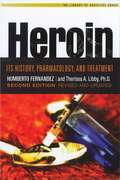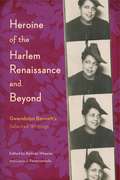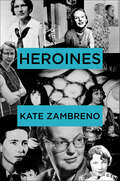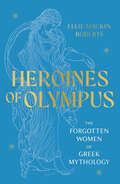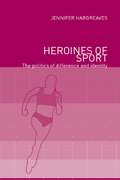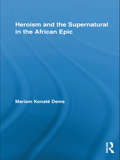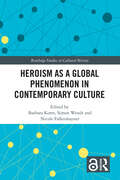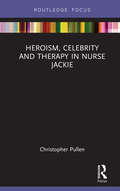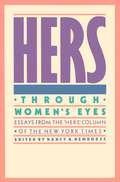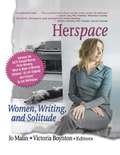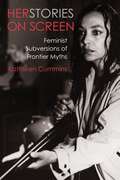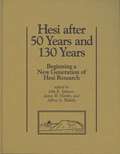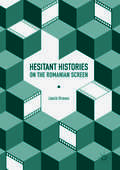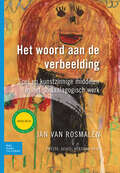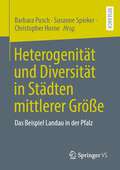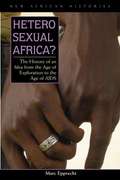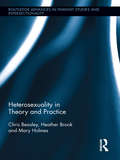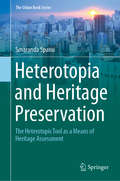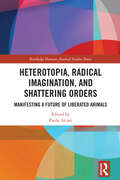- Table View
- List View
Heroin and Music in New York City
by Barry SpuntUsing narrative accounts from a sample of 69 New York City-based musicians of various genres who are self-acknowledged heroin users, the book addresses the reasons why these musicians started using heroin and the impact heroin had on these musicians' playing, creativity, and careers.
Heroin: Its History, Pharmacology & Treatment
by Therissa A. Libby Humberto FernandezAn up-to-the-minute, comprehensive examination of heroin's history, pharmacology, psychology, and sociology, Heroin offers a spellbinding account of the drug's power and persistent allure, its medicinal benefits, and its destructive nature.This updated and expanded second edition provides new research into heroin's effects on the brain, the changing attitudes and policies about methadone and medications, and the different approaches to treating heroin addicts. Included are studies of violence along the U.S.-Mexican border--which has put heroin trafficking in the spotlight--as well as a focus on how the wars in Iraq and Afghanistan have made opium a valuable commodity and a major source of funds for terrorists. Animated with vivid personal stories and vignettes, Heroin puts a human face on the long and complex story behind this notorious drug.
Heroine of the Harlem Renaissance and Beyond: Gwendolyn Bennett’s Selected Writings (G - Reference, Information and Interdisciplinary Subjects)
by Louis J. Parascandola Belinda WheelerPoet, columnist, artist, and fiction writer Gwendolyn Bennett is considered by many to have been one of the youngest leaders of the Harlem Renaissance and a strong advocate for racial pride and the rights of African American women. Heroine of the Harlem Renaissance and Beyond presents key selections of her published and unpublished writings and artwork in one volume.From poems, short stories, and reviews to letters, journal entries, and art, this collection showcases Bennett’s diverse and insightful body of work and rightfully places her alongside her contemporaries in the Harlem Renaissance—figures such as Zora Neale Hurston, Langston Hughes, and Countee Cullen. It includes selections from her monthly column “The Ebony Flute,” published in Opportunity, the magazine of the National Urban League, as well as newly uncovered post-1928 work that proves definitively that Bennett continued writing throughout the following two decades. Bennett’s correspondence with canonical figures from the period, her influence on Harlem arts institutions, and her political writings, reviews, and articles show her deep connection to and lasting influence on the movement that shaped her early career.An indispensable introduction to one of the era’s most prolific and passionate minds, this reevaluation of Bennett’s life and work deepens our understanding of the Harlem Renaissance and enriches the world of American letters. It will be of special value to scholars and readers interested in African American literature and art and American history and cultural studies.
Heroines
by Kate ZambrenoA manifesto for "toxic girls" that reclaims the wives and mistresses of modernism for literature and feminism.I am beginning to realize that taking the self out of our essays is a form of repression. Taking the self out feels like obeying a gag order―pretending an objectivity where there is nothing objective about the experience of confronting and engaging with and swooning over literature."― from HeroinesOn the last day of December, 2009 Kate Zambreno began a blog called Frances Farmer Is My Sister, arising from her obsession with the female modernists and her recent transplantation to Akron, Ohio, where her husband held a university job. Widely reposted, Zambreno's blog became an outlet for her highly informed and passionate rants about the fates of the modernist "wives and mistresses." In her blog entries, Zambreno reclaimed the traditionally pathologized biographies of Vivienne Eliot, Jane Bowles, Jean Rhys, and Zelda Fitzgerald: writers and artists themselves who served as male writers' muses only to end their lives silenced, erased, and institutionalized. Over the course of two years, Frances Farmer Is My Sister helped create a community where today's "toxic girls" could devise a new feminist discourse, writing in the margins and developing an alternative canon.In Heroines, Zambreno extends the polemic begun on her blog into a dazzling, original work of literary scholarship. Combing theories that have dictated what literature should be and who is allowed to write it―from T. S. Eliot's New Criticism to the writings of such mid-century intellectuals as Elizabeth Hardwick and Mary McCarthy to the occasional "girl-on-girl crime" of the Second Wave of feminism―she traces the genesis of a cultural template that consistently exiles female experience to the realm of the "minor," and diagnoses women for transgressing social bounds. "ANXIETY: When she experiences it, it's pathological," writes Zambreno. "When he does, it's existential." By advancing the Girl-As-Philosopher, Zambreno reinvents feminism for her generation while providing a model for a newly subjectivized criticism.
Heroines of Horticulture: A Celebration of Women Who Shaped North America's Gardening Heritage
by Stefan WhiteA celebration and a salute to 100 brave, determined, creative women over the past few centuries who have shaped North America’s heritage and landscapes through their horticulture work and contributions. Through tales of invention, creativity, dogged research, innovation, perspiration, and inspiration spanning from the early 1700s to the mid-1980s, Heroines of Horticulture offers readers insight into 100 influential women who met and overcame obstacles to contribute a horticulture legacy that has helped shape the land that surrounds us today in North America. Many of the featured women are unknown or forgotten figures of horticulture history, making this book an overdue opportunity to acknowledge their work and celebrate their achievements that have left a lasting legacy. Profiles include the following: Martha Danielle Logan (1704–1779): An early American botanist who was instrumental in seed exchanges between Britain and the North American colonies. She wrote an influential gardening advice column and was a major collector of plants endemic to the Carolinas. Annie Linda Jack (1839–1912): The first Canadian professional female garden writer. Upon her marriage, she had stipulated for 1 acre of land to be devoted to any department of horticulture she chose, the profits to be her own pocket money. She wrote about her experiences in the Rural New Yorker, under the title "A Woman's Acre." The American horticulturalist Liberty Hyde Bailey referred to Annie Linda Jack's garden as "one of the most original gardens I know." Mary Gibson Henry (1884–1967): An American botanist and plant collector from Lower Merion Township, Pennsylvania, near Philadelphia, who also served as president of the American Horticultural Society. The daylily Hymenocallis henryae is named in her honor. Nelva Weber (1908–1990): An American landscape architect who wrote extensively about landscape design. She opened her practice in 1945 in New York City. Prior to that, she worked on the Palisades Parkway with C. C. Combs. She was also employed by the architecture firm Shaw Maess & Murphy and later as a designer on city parks for the New York City Parks Department. And many more Heroines of Horticulture is the perfect addition to the shelves and coffee tables of gardening enthusiasts and women’s history and feminist history readers and makes a great gift for anyone with a love of gardening or landscape design and history.
Heroines of Olympus: The Forgotten Women of Greek Mythology
by Ellie Mackin RobertsCunning, monstrous, virtuous. Rediscover the overlooked women of Greek myth.Goddesses and mortals, warriors and muses, women are at the heart of ancient Greek folklore, but their stories have long been eclipsed by those of men. Heroines of Olympus tells the tales of fifty of these enthralling women, including majestic Athena, goddess of war; vengeful Nemesis, goddess of retribution; and gladiatorial Hippolyta, queen of the Amazon.With beautifully written retellings of Greek myths and a fascinating dive into their place in history, alongside exquisite illustrations, celebrate the dazzling and diverse heroines of ancient Greece.
Heroines of Sport: The Politics of Difference and Identity
by Jennifer HargreavesHeroines of Sport looks closely at different groups of women whose stories have been excluded from previous accounts of women's sports and female heroism. It focuses on five specific groups of women from different places in the world: Black women in South Africa; Muslim women from the Middle East; Aboriginal women from Australia and Canada; and lesbian and disabled women from different countries worldwide. It also asks searching questions about colonialism and neo-colonialism in the women's international sport movement.The particular groups of women featured in the book reflect the need to look at specific categories of difference relating to class, culture, disability, ethnicity, race, religion and sexual orientation. In her account, Jennifer Hargreaves reveals how the participation of women in sport across the world is tied to their sense of difference and identity. Based on original research each chapter includes material which relates to significant political and cultural developments.Heroines of Sport will be invaluable reading for undergraduate and postgraduate students of sport sociology, and will also be relevant for students working in women's studies and other specialized fields, such as development studies or the politics of Aboriginality, disability, Islam, race and sexuality.
Heroism and the Black Intellectual
by Jerry Gafio WattsBefore and after writing Invisible Man, novelist and essayist Ralph Ellison fought to secure a place as a black intellectual in a white-dominated society. In this sophisticated analysis of Ellison's cultural politics, Jerry Watts examines the ways in which black artists and thinkers attempt to establish creative intellectual spaces for themselves. Using Ellison as a case study, Watts makes important observations about the role of black intellectuals in America today. Watts argues that black intellectuals have had to navigate their way through a society that both denied them the resources, status, and encouragement available to their white peers and alienated them from the rest of their ethnic group. For Ellison to pursue meaningful intellectual activities in the face of this marginalization demanded creative heroism, a new social and artistic stance that challenges cultural stereotypes. For example, Ellison first created an artistic space for himself by associating with Communist party literary circles, which recognized the value of his writing long before the rest of society was open to his work. In addition, to avoid prescriptive white intellectual norms, Ellison developed his own ideology, which Watts terms the 'blues aesthetic.' Watts's ambitious study reveals a side of Ellison rarely acknowledged, blending careful criticism of art with a wholesale engagement with society.
Heroism and the Supernatural in the African Epic (African Studies)
by Mariam Konaté DemeThere exists a strong tendency within Western literary criticism to either deny the existence of epics in Africa or to see African literatures as exotic copies of European originals. In both cases, Western criticism has largely failed to acknowledge the distinctiveness of African literary aesthetics. This book revises traditional literary canons in examining the social, cultural and emotional specificity of African epics. Mariam Konate Deme highlights the distinguishing features that characterize the African epic, emphasizing the significance of the fantastic and its use as an essential element in the dramatic structure of African epics. As Deme notes, the fantastic can be fully appreciated only against the cosmological background of the societies that produce those heroic tales. This book not only contributes to the scholarship on African oral literature, but also adds reshapes our understanding of heroic literature in general.
Heroism as a Global Phenomenon in Contemporary Culture (Routledge Studies in Cultural History #71)
by Simon Wendt Nicole Falkenhayner Barbara KorteHeroes and heroic discourse have gained new visibility in the twenty-first century. This is noted in recent research on the heroic, but it has been largely ignored that heroism is increasingly a global phenomenon both in terms of production and consumption. This edited collection aims to bridge this research void and brings together case studies by scholars from different parts of the world and diverse fields. They explore how transnational and transcultural processes of translation and adaptation shape notions of the heroic in non-Western and Western cultures alike. The book provides fresh perspectives on heroism studies and offers a new angle for global and postcolonial studies.
Heroism, Celebrity and Therapy in Nurse Jackie (Routledge Focus on Television Studies)
by Christopher PullenThis book presents an examination of the television series Nurse Jackie, making connections between the representational processes and the audience consumption of the series. A key point of reference is the political and performative potential of Nurse Jackie with regards to its progressive representation of prescription drug addiction and its relationship to the concept of quality television. It deconstructs Nurse Jackie ’s discursive potential, involving intersections with contemporary notions of genre, heroism, celebrity, therapy and feminism. At the same time this book foregrounds the self-refl exive educational potential of the series, largely enabled by the scriptwriters and the leading actor Edie Falco.
Hers: Through Women's Eyes
by Nancy NewhouseThis collection includes essays from the "Hers" column of The New York Times, edited by Nancy Newhouse.
Herspace: Women, Writing, and Solitude
by J Dianne Garner Victoria Boynton Jo MalinThis collection delves deeply into the power of solitude in a richly detailed exploration of the lives of women writers! The essays in this fascinating volume combine literary theory, autobiography, performance, and criticism, while opening minds and expanding concepts of women's roles both in the home and within academia along the way. Herspace: Women, Writing, and Solitude begins with a discussion of the importance of solitude to the works of a variety of writers, including Margaret Atwood, May Sarton, Virginia Woolf, Marguerite Duras, and Zora Neale Hurston, and then moves on to an examination of the actual solitary spaces of women writers. The book concludes with the stories of modern women asserting their right to a space of their own. These essays, full of pain and new growth, lessons learned and battles fought, resound with the honesty and courage the authors have found in the process of truly making their own homes. Herspace examines: the stereotyped spinster solitude as a process and a journey women's prison literature cars, empty nests, kitchen counters, and other found spaces for writing the meaning of a home of one's own creating beauty in solitary settings Contributors to Herspace have made a conscious effort to integrate the personal with the academic, and the result is a volume of surprising intimacy, a window into the world of women writers past and present actively engaging solitude. From finding and defining the muse to the identity issues of home ownership, Herspace, which includes Jan Wellington's essay "What to Make of Missing Children (A Life Slipping into Fiction)," (winner of the 2003 NCTE Donald Murray Prize for "the best creative essay about teaching and/or writing published during the preceding year") provides you with the perspectives of women who are living these issues. As the editors write: "The solitary space itself enables the writing process, protects it. And women, more than men, need this enabling protection. Women need to claim their own space, to bargain and plan and keep out of sight that solitary space in which to commune with their thoughts and feelings, to experience their creative process intimately." Herspace explores these women's experiences, revealing the unique creativity that comes from solitude.
Herstories on Screen: Feminist Subversions of Frontier Myths
by Professor Kathleen CumminsFrom the late 1970s into the early 1990s, a generation of female filmmakers took aim at their home countries’ popular myths of the frontier. Deeply influenced by second-wave feminism and supported by hard-won access to governmental and institutional funding and training, their trailblazing films challenged traditionally male genres like the Western. Instead of reinforcing the myths of nationhood often portrayed in such films—invariably featuring a lone white male hero pitted against the “savage” and “uncivilized” native terrain—these filmmakers constructed counternarratives centering on women and marginalized communities. In place of rugged cowboys violently removing indigenous peoples to make the frontier safe for their virtuous wives and daughters, these filmmakers told the stories of colonial and postcolonial societies from a female and/or subaltern point of view.Herstories on Screen is a transnational study of feature narrative films from Australia, Canada, the United States, and New Zealand/Aotearoa that deconstruct settler-colonial myths. Kathleen Cummins offers in-depth readings of ten works by a diverse range of women filmmakers including Jane Campion, Julie Dash, Merata Mita, Tracey Moffatt, and Anne Wheeler. She reveals how they skillfully deploy genre tropes and popular storytelling conventions in order to critique master narratives of feminine domesticity and purity and depict women and subaltern people performing acts of agency and resistance. Cummins details the ways in which second-wave feminist theory and aesthetics informed these filmmakers’ efforts to debunk idealized Anglo-Saxon femininity and motherhood and lay bare gendered and sexual violence and colonial oppression.
Hesi after 50 Years and 130 Years: Beginning a New Generation of Hesi Research (Joint Archaeological Expedition to Tell el-Hesi)
by John R. Spencer, James W. Hardin, and Jeffrey A. BlakelyTell el-Hesi is located near the modern city of Qiryat Gat in the Southern District of Israel, 23 kilometers from the Mediterranean Sea. The site, which covers 35–40 acres, includes both an acropolis and a lower city. Occupation of the site began as early as the Neolithic period, and the city grew significantly during the Early Bronze Age before being abandoned until the Late Bronze Age. The latest phase of occupation occurred during the Hellenistic period. The acropolis was in use for almost two thousand years. This volume is the first in a new iteration of the Joint Archaeological Expedition to Tell el-Hesi series that builds on previously published volumes. It publishes a final report for part of one of Tell el-Hesi’s excavation fields; a reevaluation of the stratigraphic findings of the original 1891–1892 excavations on Tell el-Hesi, based on excavation work from the 1970s and 1980s; in-depth studies of groups of small finds from the tell; and zooarchaeological analyses that widen the investigative perspective to include the region around the tell.Paying tribute to the long excavation history at Tell el-Hesi, the contributors to this volume employ state-of-the-art scientific methods that honor the careful work and findings of a century of excavations. Hesi After 50 Years and 130 Years will be an important reference for scholars researching the history and culture of southern Palestine.
Hesitant Histories on the Romanian Screen
by László StrauszThis book argues that hesitation as an artistic and spectatorial strategy connects various screen media texts produced in post-war Romania. The chapters draw a historical connection between films made during the state socialist decades, televised broadcasts of the 1989 Romanian revolution, and films of the new Romanian cinema. The book explores how the critical attitude of new Romanian cinema demonstrates a refusal to accept limiting, binary discourses rooted in Cold War narratives. Strausz argues that hesitation becomes an attempt to overcome restrictive populist narratives of the past and present day. By employing a performative and mobile position, audiences are encouraged to consider conflicting approaches to history and social transformation.
Hestorian Taotao Tano': History of the Chamorro People
by Political Status Education Coordinating CommissionCONTENTS PART I: CHAMORRO PREHISTORY Introduction UNIT 1: The Quest for a Home and Identity Section A Clues to the Puzzle Clues from Ancestral Remains Clues from Language Clues from Tools and Pottery Clues from Plants Putting the Clues Together Section B Looking for a Home Section C The Pacific Section D The Navigators Section E Settlements UNIT 2: The Life of the Ancient Chamorros Section A Economics and Society Section B Home and Family Section C The Manmaga'lahi and Manmaga'haga Section D The Guma' Uritao Section E Marriage and Home Section F Beliefs Section G Magic and Medicine PART II: CONTACT WITH THE EUROPEANS Introduction UNIT 1: Contact with the Europeans Section A A Tale about How it might have Happened Section B The Search for Wealth and Power Section C Conversion, Conquest and Colonization Section D The Religion of the Chamorros UNIT 2: Bringing Christianity to the Chamorros Section A Padre San Vitores and the Chamorros Section B Trouble Over Differences Section C Chamorro Leaders Who Rebelled Section D Guam in the 18th and 19th Centuries Section E The Continuing Role of Chamorro Women English Glossary Chamorro Glossary
Het woord aan de verbeelding: Spel en kunstzinnige middelen in het sociaalagogisch werk
by Jan RosmalenHet woord aan de verbeelding gaat over de mogelijkheden van spel en kunstzinnige media voor het sociaalagogisch werk. In het boek worden de mogelijkheid van het creëren van andere werkelijkheden (spel en vrijplaats), het uitlokken van intensieve ervaringen (flow) en non-verbale communicatie voor het agogisch werk van een heldere theoretische basis voorzien.In de tweede deel van het boek worden moderne benaderingswijzen als ervaringsleren, narratief werken en dialooggestuurd werken beschreven en verbonden met 'de vrijplaats' en de non-verbale media. Ook komen hier de praktische toepassingsmogelijkheden voor het sociaalagogisch werk aan bod.Deze geheel herziene uitgave van Het woord aan de verbeelding is meer aangepast aan de mogelijkheden en eisen van de student van deze tijd: vlot geschreven, toegankelijk - met gebruikmaking van digitale mogelijkheden ter verdieping.Er zijn tekeningen, foto's en schematische overzichten toegevoegd voor meer overzicht en overdracht. De informatie is up to date gemaakt en met onderzoek onderbouwd. De begrippen 'vrijplaats', 'flow' en non-verbale communicatie hebben een meer prominente plek in het geheel gekregen.Op de bijbehorende website staat verdiepingsmateriaal. De website beschrijft uitgebreide en zeer gevarieerde opdrachten voor studenten. Daarnaast toont de website voorbeelden, praktijkcasussen en links naar beeldmateriaal uit de praktijk.
Heterogenität und Diversität in Städten mittlerer Größe: Das Beispiel Landau in der Pfalz
by Sebastian Fitz-KlausnerGesellschaftliche Vielfalt wird in der Regel mit Metropolen assoziiert und in der Wissenschaft primär als Phänomen großstädtischen Lebens reflektiert. Anhand ausgewählter Fallbeispiele aus Landau in der Pfalz zeigt der Sammelband jedoch auf, dass Heterogenität und Diversität auch in Mittelstädten gesellschaftliche Normalität war und ist. Auf der Basis empirischer Befunde formuliert der Band zudem theoretische Überlegungen zu Heterogenität und Diversität in Städten mittlerer Größe, wodurch er einen Beitrag zur Überwindung eines wichtigen Forschungsdesiderats – der wissenschaftlichen Reflexion gesellschaftlicher Vielfalt jenseits großstädtischer Metropolen – leistet.
Heteronormativity in Eighteenth-Century Literature and Culture
by Ana de Boe Abby CoykendallThe resurgence of marriage as a transnational institution, same-sex or otherwise, draws upon as much as it departs from enlightenment ideologies of sex, gender, and sexuality which this collection aims to investigate, interrogate, and conceptualize anew. Coming to terms with heteronormativity is imperative for appreciating the literature and culture of the eighteenth century writ large, as well as the myriad imaginaries of sex and sexuality that the period bequeaths to the present. This collection foregrounds British, European, and, to a lesser extent, transatlantic heteronormativities in order to pose vital if vexing questions about the degree of continuity subsisting between heteronormativities of the past and present, questions compounded by the aura of transhistoricity lying at the heart of heteronormativity as an ideology. Contributors attend to the fissures and failures of heteronormativity even as they stress the resilience of its hegemony: reconfiguring our sense of how gender and sexuality came to be mapped onto space; how public and private spheres were carved up, or gendered and sexual bodies socially sanctioned; and finally how literary traditions, scholarly criticisms, and pedagogical practices have served to buttress or contest the legacy of heteronormativity.
Heterosexual Africa?: The History Of An Idea From The Age Of Exploration To The Age Of Aids (New African Histories)
by Marc EpprechtHeterosexual Africa? The History of an Idea from the Age of Exploration to the Age of AIDS builds from Marc Epprecht’s previous book, Hungochani (which focuses expli citly on same-sex desire in southern Africa) to explore the historical processes by which a singular, heterosexual identity for Africa was constructed—by anthropologists, ethnopsychologists, colonial officials, African elites, and most recently, health care workers seeking to address the HIV/AIDS pandemic. This is an eloquently written, accessible book, based on a rich and diverse range of sources, that will find enthusiastic audiences in classrooms and in the general public. Epprecht argues that Africans, just like people all over the world, have always had a range of sexualities and sexual identities. Over the course of the last two centuries, however, African societies south of the Sahara have come to be viewed as singularly heterosexual. Epprecht carefully traces the many routes by which this singularity, this heteronormativity, became a dominant culture. A fascinating story that will surely generate lively debate Epprecht makes his project speak to a range of literatures—queer theory, the new imperial history, African social history, queer and women’s studies, and biomedical literature on the HIV/AIDS pandemic. He does this with a light enough hand that his story is not bogged down by endless references to particular debates. Heterosexual Africa? aims to understand an enduring stereotype about Africa and Africans. It asks how Africa came to be defined as a “homosexual-free zone” during the colonial era, and how this idea not only survived the transition to independence but flourished under conditions of globalization and early panicky responses to HIV/AIDS.
Heterosexual Histories (Sexual Cultures)
by Michele Mitchell Rebecca L DavisThe history of heterosexuality in North America across four centuriesHeterosexuality is usually regarded as something inherently “natural”—but what is heterosexuality, and how has it taken shape across the centuries? By challenging ahistorical approaches to the heterosexual subject, Heterosexual Histories constructs a new framework for the history of heterosexuality, examining unexplored assumptions and insisting that not only sex but race, class, gender, age, and geography matter to its past. Each of the fourteen essays in this volume examines the history of heterosexuality from a different angle, seeking to study this topic in a way that recognizes plurality, divergence, and inequity.Editors Rebecca L. Davis and Michele Mitchell have formed a collection that spans four centuries, addressing the many different racial groups, geographies, and subcultures of heterosexuality in North America. The essays range across disciplines with experts from various fields examining heterosexuality from unique perspectives: a historian shows how defining heterosexuality, sex, and desire were integral to the formation of British America and the process of colonization; a legal scholar examines the connections between race, sexual citizenship, and nonmarital motherhood; a gender studies expert analyzes the Clinton-Lewinsky scandal, and explores the Intersectionsof heterosexuality with shame and second-wave feminism. Together, these essays explain how differently earlier Americans understood the varieties of gender and different-sex sexuality, how heterosexuality emerged as a dominant way of describing gender, and how openly many people acknowledged and addressed heterosexuality’s fragility.By contesting presumptions of heterosexuality’s stability or consistency, Heterosexual Histories opens the historical record to interrogations of the raced, classed, and gendered varieties of heterosexuality and considers the implications of heterosexuality’s multiplicities and changes. Providing both a sweeping historical survey and concentrated case studies, Heterosexual Histories is a crucial addition to the field of sexuality studies.
Heterosexuality in Theory and Practice (Routledge Advances in Feminist Studies and Intersectionality)
by Chris Beasley Mary Holmes Heather BrookThis book explores heterosexualities in their complex and everyday expressions. It engages with theories about the intersection of sexuality with other markers of difference, and gender in particular. The outcome will productively upset equations of heterosexuality with heteronormativity and accounts that cast heterosexuality in "sex critical, sex as danger" terms. Queer/feminist ‘pro-sex’ perspectives have become prevalent in analyses of sexuality, but in these approaches queer becomes the site of subversive, transgressive, exciting and pleasurable sex, while heterosex, if mentioned at all, continues to be seen as objectionable or dowdy. It challenges heterosexuality’s comparative absence in gender/sexuality debates and the common constitution of heterosexuality as nasty, boring and normative. The authors develop an innovative analysis showing the limits of the sharply bifurcated perspectives of the "sex wars". This is not a revisionist account of heterosexuality as merely one option in a fluid smorgasbord, nor does it dismiss the weight of feminist/pro-feminist critiques of heterosexuality. This book establishes that if relations of domination do not constitute the analytical sum of heterosexuality, then identifying its range of potentialities is clearly important for understanding and helping to undo its "nastier" elements.
Heterotopia and Heritage Preservation: The Heterotopic Tool as a Means of Heritage Assessment (The Urban Book Series)
by Smaranda SpanuThis book approaches the field of built heritage and its practices by employing the concept of heterotopia, established by the French philosopher Michel Foucault. The fundamental understandings of heritage, its evolution and practices all reveal intrinsic heterotopic features (the mirror function, its utopic drive, and its enclave-like nature). The book draws on previous interpretations of heterotopia and argues for a reading of heritage as heterotopia, considering various heritage mechanisms – heritage selection, conservation and protection practices, and heritage as mnemonic device – in this regard. Reworking the six heterotopic principles, an analysis grid is designed and applied to various built heritage spaces (vernacular, religious architecture, urban 19th century ensembles). Guided through this theoretical itinerary, the reader will rediscover the heterotopic lens as a minor, yet promising, Foucauldian device that allows for a better understanding of heritage and its everyday practices.
Heterotopia, Radical Imagination, and Shattering Orders: Manifesting a Future of Liberated Animals (Routledge Human-Animal Studies Series)
by Paula ArcariThis volume takes ending the oppression of other animals seriously and confronts the question ‘What would happen to all the animals?’ by showcasing real, promissory, and imagined counter-sites or heterotopia, where animals ‘happen’ in different ways, free of anthropocentric orders of value and purpose.Rejecting persistent understandings of the oppression of nonhuman animals, across the entire breadth of the Animal-Industrial Complex (A-IC), as either non-existent, unproblematic, and/or fundamentally unalterable – open to merely being reduced in scale or made less harmful – the collection offers readers a variety of pathways towards radically ‘disordered’ ways of thinking about and relating to other animals. Over 14 chapters, authors describe more liberatory relational reconfigurations playing out in the present and undertake conceptual, imaginative, and embodied explorations of liberatory futures. The chapters are united by a common commitment to heterotopic disturbance – to contesting and subverting the anthropo-capitalo-centric space in which we live. Each chapter approaches this subversion in its own way, using prefiguration, restorying, speculation, radical imagination, and combinations thereof, to disturb or shatter orders, explore the kinds of liberation and resistance their disturbance demonstrates, demands, or embodies, and ultimately illustrate exactly what would or could happen to all the animals.Heterotopia, Radical Imagination, and Shattering Orders will appeal to scholars, students, and individuals interested not only in challenging normalised binaries, hierarchies, and orders of value, both human and nonhuman, but in creating and realising liberatory alternatives. Scholar-activists, activists, professionals working in animal advocacy, and anyone undertaking activities aimed at radically changing how other animals are understood and used will also find inspiration, new insights, and information that enhance their current methods and approaches. Some readers may also find simply confirmation and comfort in the knowledge that so many others are working in solidarity with the ‘disordered’ belief that shattering the A-IC is possible.

